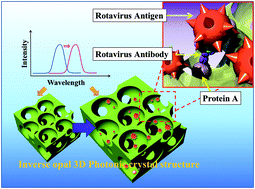Direct label-free detection of Rotavirus using a hydrogel based nanoporous photonic crystal†
Abstract
To date, there is no commercial point-of-care test (POCT) for intact virus detection. A POCT should show high sensitivity and have proper structure through simple and cost effective fabrication; moreover it should not require a complex and bulky instrument for measurement. In this study, a direct label-free biosensor based on 3D photonic crystal (PC) structures for Rotavirus has been demonstrated, which can be developed for POCT. The proposed sensor can detect the target with viral loading from 6.35 μg ml−1 to 1.27 mg ml−1 without any sample pretreatment. Sensitivity and selectivity performance are analyzed quantitatively by measuring peak wavelength value (PWV) and comparing the performance using an ELISA assay. In order to facilitate the target virus accessibility to inner structures in the sensor, the hydrogel based inverse opal structure is etched by O2 plasma and the connection window between nanopores becomes enlarged. This process is critical for enhancing virus sensing performance. Our PWV shift range is larger than of the shift in a 1D photonic crystal based virus sensor because the larger surface area in 3D inverse opal structures is realized. These results show that the proposed method is useful for developing a direct and easy-to-use virus detection kit in the form of a POCT in the near future.


 Please wait while we load your content...
Please wait while we load your content...